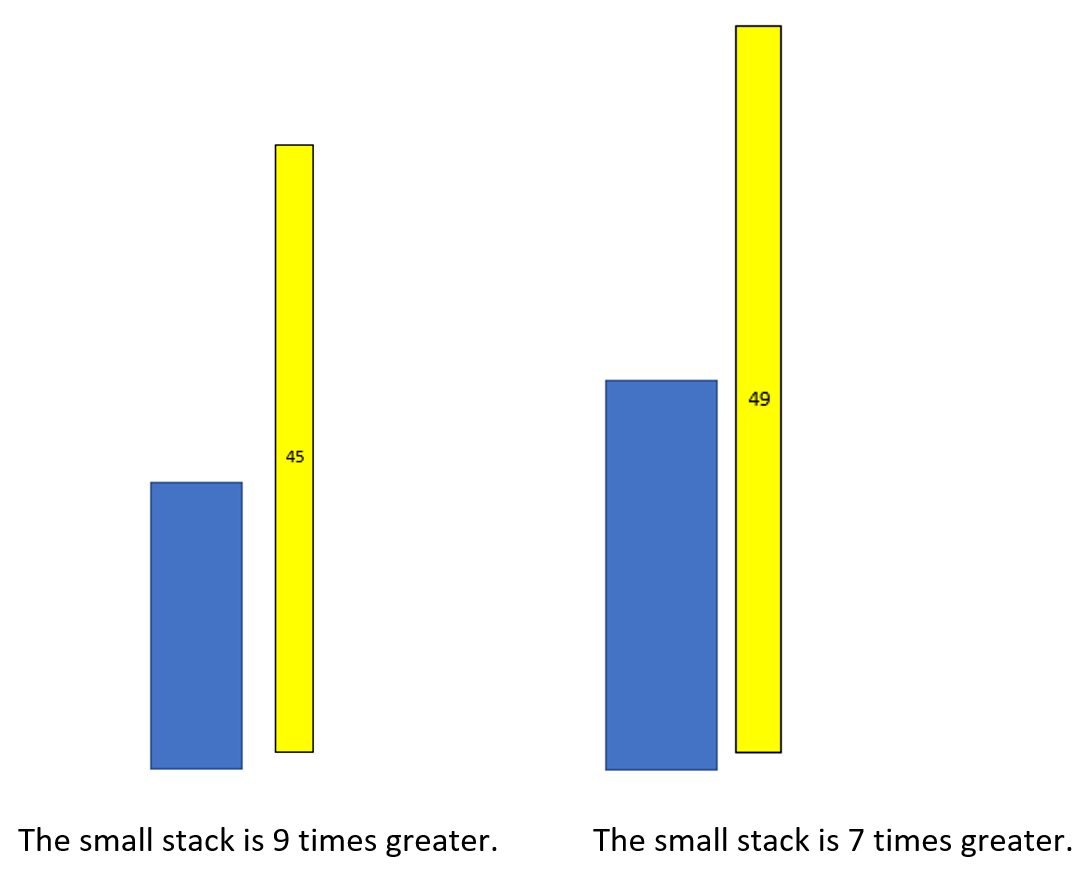Purpose
The purpose of this activity is to support students in applying division to identify the initial size of a stack of cubes in a scaling situation.
Achievement Objectives
NA3-1: Use a range of additive and simple multiplicative strategies with whole numbers, fractions, decimals, and percentages.
NA3-2: Know basic multiplication and division facts.
Required Resource Materials
- Connecting cubes
Activity

 Show students a diagram showing a single stack of an even number of cubes, such as 24. Briefly show students a diagram of a smaller stack of cubes (e.g. 4), before quickly masking it under a piece of paper.
Show students a diagram showing a single stack of an even number of cubes, such as 24. Briefly show students a diagram of a smaller stack of cubes (e.g. 4), before quickly masking it under a piece of paper.
This stack of 24 cubes is six times more than the stack under this piece of paper.
How big is the smaller stack?
Let students work out the problem in any way. You might allow them to work in pairs or ask them to work independently to gauge their individual levels of understanding. Have students share their answers and strategies with the class. You might record a few key statements, equations, or answers on the board for the class to consider.
- Discuss the use of different strategies - drawing attention to those that are more efficient. Compare "searching" the six-times facts (e.g. ? x 6 = 24) to using division (e.g. 24 divided by ? equals four).
- Reveal the small stack and confirm the answer.
- Write multiplication and division equations for the situation:
6 x [ ] = 24
24 ÷ 6 = [ ]
Discuss the meaning of the symbols in the situation, including what the unknown means (size of the initial stack). Note that the multiplicand is missing which is conventionally the second factor in a multiplication equation.
- Pose similar problems that involve finding the initial stack when given a target stack and the scalar (multiplier). Support the use of relevant mathematical language and te reo māori kupu (e.g, times, of, multiply - whakarea, divide - whakawehe). Each example should include discussion of the following:
- “times as” statements, such as “45 is 9 times as much as what number?” or “9 times what number equals 45?”
- relevant multiplication and division statements.
- relevant fraction multiplication statements, such as: 9 x [ ] = 45, 45 ÷ 9 = [ ] and 19 x 45 = [ ].
Examples might include:
- Challenge students to work in appropriate groupings (e.g. that scaffold, extend, or consolidate understanding and knowledge) and use division to solve missing multiplier problems. Choice of numbers plays an important role in convincing students about the power of division. Begin with facts that students usually have strong knowledge of, such as twos, fives, and tens.
Here is a 70-stack. (diagram)
It is ten times greater than the stack I have in my hand.
How big is the stack in my hand? Explain how you know.
- Discuss students’ strategies. Scanning the ten-times facts can be less efficient than asking “what number multiplied by ten equals 70? (10 x [ ] = 70)”
Share that division is the same as looking for the missing multiplicand (initial stack), 70 ÷ 10 = [ ].
- Pose similar unknown multiplier problems with accessible facts, such as:
- Here is a 30-stack.
It is five times greater than the stack in my hand. - Here is a 100-stack.
It is two times greater than the stack in my hand. - Here is an 18-stack.
It is nine times greater than the stack in my hand.
- Here is a 30-stack.
Include problems that involve “times less”. For example:
- This stack (8) is six times less than the stack under this piece of paper.
How big is the larger stack?
Look for students to reverse their thinking using equations like:
6 x 8 = [ ] or [ ] ÷ 6 = 8
Next steps
- Increase the level of abstraction by progressing from working with diagrams to only equations.
- Ask anticipatory questions aimed at divisibility like “we know that this 36-stack is four times greater than the smaller stack. How might we find the size of the smaller stack? What facts might we use?”
- Extend the difficulty of the comparisons so students apply a full range of their basic multiplication facts and begin to apply division equivalents of those facts.
- Encourage the application of students' basic multiplication and division facts by presenting them with contextually relevant problems (e.g. there are 30 cars in the carpark and 6 bikes. How many times smaller is the group of bikes than the group of cars?) or by asking students to make up similar problems with the use of other relevant materials (e.g. stick figures, animal toys).
Add to plan
Level Three